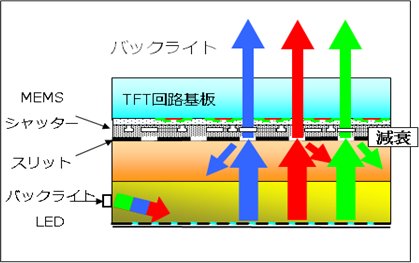The Japanese company Sharp is apparently managed the feat,> to combine the advantages of IGZO- and MEMS technology Qualcomm has developed a tablet, the with a particularly power saving while high-quality panel should be provided, and on top of that easily under sunlight can be read. In the first half of next year, the first devices with the new displays are coming on the market.
Although there are now hardly any fault with the image quality of displays current smartphones and tablets something that will remain with the current efficiency a further weighty problem to be solved. Conventional OLEDs and LCDs can certainly make for a brilliant visual experience, but often is just the display mainly responsible for the high power consumption of the device. To counteract this, Sharp and Qualcomm have joined forces and developed a new display, which, combines the in-house technology IGZO and microelectromechanical systems (or MEMS) of Pixtronix, acquired by Qualcomm some time ago to a novel hybrid solution.
Sharp IGZO displays are among others in Apple iPads for use and are characterized by the material I ndium- G Allium Z to increment O of xid, which gives them the name. Due to the increased electron mobility as compared to the back coatings used in conventional LCDs are not only faster response times for IGZO displays possible, but also considerably higher screen resolutions. The color representation of the cost of production here is quite natural and comparable with conventional IPS panels, comparable low. Qualcomm MEMS technology features among others in Mirasol displays for use: There tiny mirrors to represent each individual pixel are aligned and used the incident sunlight instead of backlight by mechanical systems, which unlike e-ink displays also a color representation is possible. Furthermore, in a static image does not require electricity, only the orientation of the mirrors requires electrical impulses.
It is likely that the IGZO technology has been extended by a layer with micro electro mechanical systems, by about at brighter sunlight to make the backlight obsolete. Nor is the panel in the development phase, a first prototype has already been presented by Sharp. However, this has only a 1280 x 800 pixel sharp 7-inch display. Presumably, the relatively low resolution is due to technical reasons and one of the disadvantages of the new technology – perhaps the resolution but was deliberately kept low also in favor of energy efficiency. Next year already the first for the consumer market imaginary devices coming onto the market, at CES or MWC is Sharp the opportunity certainly use to present the devices to the public.
Would you favor the battery life accept a low-resolution or high less good display? Logs you out as always in the comments to word
Source:. Sharp (Google Translate) [via Pocket Now]
Follow androidnext on Facebook
<- Last Change:! 10/08/2014 22:45:39 -> <- plista wp version 1.3.6 -> Related articles

No comments:
Post a Comment